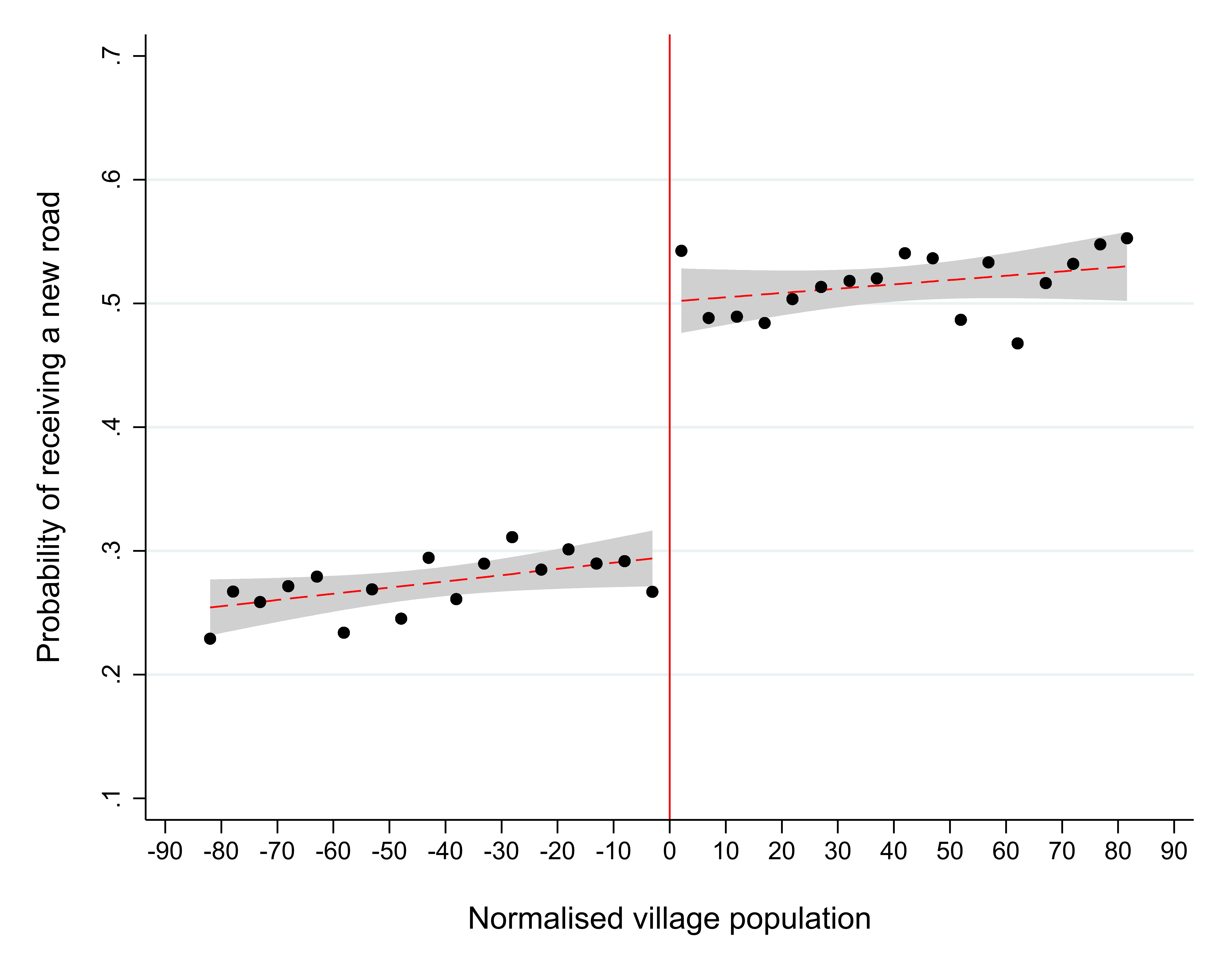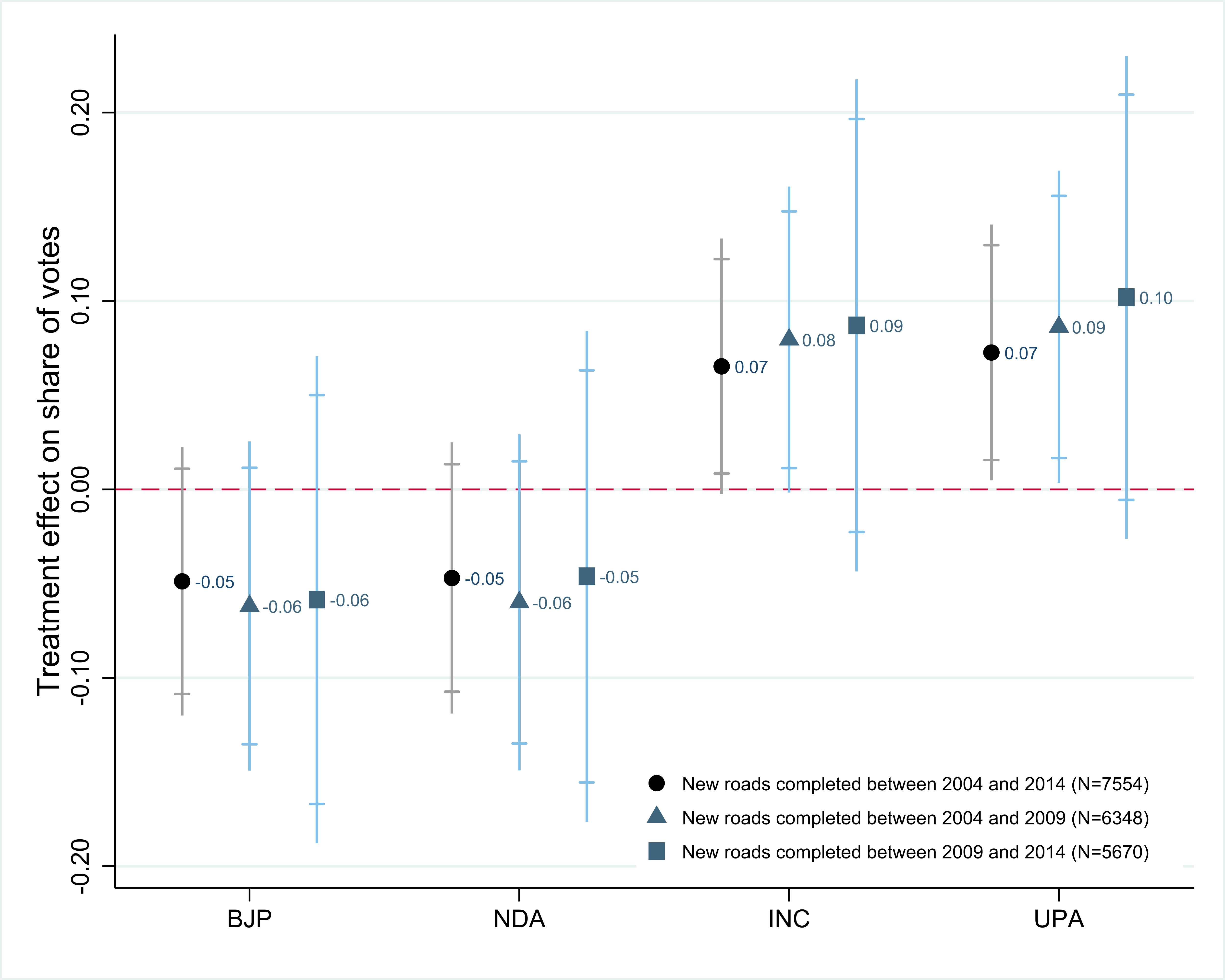
Evidence from road construction in India shows that there are clear political gains from investing in large scale public infrastructure projects. The price of a vote however is substantial and may be overshadowed by more cost-effective short-term vote buying policies.
Investment in large scale public infrastructure projects is critical to bring about and sustain economic growth (Brooks and Donovan 2020, Lipscomb et al. 2013). Analysis by the McKinsey Global Institute suggests that the world needs to invest an average of $3.3 trillion annually just to sustain current economic growth rates. Emerging economies, with the largest unexploited efficiency gains from greater infrastructure investment, account for 60% of that need. Despite the evident necessity to expand public infrastructure the scheduled investment to take place globally from 2015 to 2030 is only $2.2 trillion, resulting in what has been coined as the “global infrastructure gap” (Gardner and Henry 2021).
What are the major barriers that are preventing this critical investment in developing countries? One aspect is obviously a lack of finance (Fay et al. 2021). Another contributing, yet less explored factor, could be that the political incentives are not large enough to promote investment.
The politics of rural road construction in India
In our research (Boudot-Reddy and Butler 2024), we study the voter response to a nationwide rural road building programme. The government initiative known as Pradhan Mantri Gram Sadak Yojana (PMGSY) brought paved roads to nearly 200,000 villages between 2000 to 2014 at a cost of almost $40 billion. The Indian National Congress (INC) led coalition, the United Progressive Alliance (UPA), which won the 2004 general election, took control of implementing the programme. By the time of the 2014 general election, the UPA had been in power for two five-year mandates and overseen the vast majority of new road construction. During this period the Bharatiya Janata Party (BJP) led coalition, the National Democratic Alliance (NDA), was the main opposition party.
While programmes aimed at improving public infrastructure have been implemented by governments around the world, evaluating the causal impact of access to these interventions on electoral outcomes is often challenging. This is partly because governments are known to leverage their power to target public goods towards specific groups and locations (Lehne et al. 2018). This targeting may be motivated by potential political gains, making it hard to attribute voting behaviour to the local infrastructure investment.
Identifying voter response
A key feature of road construction under the PMGSY programme was that villages were only eligible to be awarded a new road if their population exceeded a discrete state specific threshold of either 500 or 1,000 inhabitants. As a result, we estimate that villages with a population just above these thresholds were approximately 22% more likely to have been awarded a new road by the time of the 2014 general election (Figure 1). Before receiving a new road, a village just above or below these population thresholds would have been on average almost identical. Hence any shift in the economic outcomes and voting patterns in villages treated by the PMGSY programme can be attributed solely to road construction in a fuzzy regression discontinuity design.
Figure 1: Effect of PMGSY eligibility rules on road construction

Note: The figure plots the probability of getting a new road under PMGSY by 2014 against village population in the 2001 Population Census. Village population is standardised by subtracting the eligibility threshold.
The impact of a new rural road
We find that receiving a new road significantly improved the integration of villages to the wider economy with increased access to transportation services. Additionally, evaluations of the same programme show that road connectivity leads to increased access to finance (Agarwal et al. 2023 – VoxDev), workers moving out of agriculture and improvements in education but no substantial effects on income, assets, or consumption (Adukia et al. 2022 – VoxDev).
Having been exposed to the government’s PMGSY programme and the impact of a new rural road on the village economy, did the electorate integrate this public infrastructure investment in their voting decision? Our results indicate that they did. We estimate that direct beneficiaries of the PMGSY rewarded the UPA for bringing a road to their village with a 7.3% increase in the vote share (Figure 2). This vote dividend appears to be sustained over two general elections. Focusing on roads built before the 2009 general election, where voters have already had an opportunity to reward politicians at the ballot box, we continue to see a significant increase in the share of votes to the UPA (Figure 2). This suggests long-term political benefits to investment in public infrastructure. What’s more, the political gains are not limited to the direct beneficiaries of the PMGSY programme. We find evidence that non-beneficiary villages within a 2km radius of a newly constructed rural road also increase their vote share to the UPA by a similar amount.
Figure 2: Impact of a new road on share of votes to political parties

Note: The figure shows regression discontinuity results for the share of votes to the two main political parties and their alliance. The bars indicate a 95% confidence interval, and the perpendicular line indicates a 90% confidence interval.
What is the price of a vote?
Evidence from the economic voting literature has predominantly painted a picture of myopic voters that place excessive weight on measures immediately prior to elections when evaluating incumbent parties and candidates. Encouraging governments to leverage short-term re-election strategies can be problematic, as it may lead governments to neglect potentially ambitious public capital investment programmes. Importantly, this work allows us to put a price on a vote when politicians are considering investing in public infrastructure. Given the average cost of a new road was $136,806 and considering the voting-age population across both direct beneficiary and spill-over villages, we estimate the price of a single vote to be $507, which corresponds to 32.5% of GDP per capita in India in 2014. This is quite substantial, especially in comparison to evidence from vote buying through a food subsidy programme in Turkey suggesting the cost of a vote to be only $22, or 5.3% of GDP per capita in 2019 (Kaba 2022). While voters incorporate large-scale public infrastructure investment in their accountability mechanism, the cost effectiveness of short-term vote buying may continue to exacerbate the “global infrastructure gap”.
References
Agarwal, S, A Mukherjee, and S L Naaraayanan (2023), “Roads and loans,” Review of Financial Studies, 36: 1508–1547. VoxDev article: https://voxdev.org/topic/infrastructure/building-rural-roads-india-increased-lending-banks
Asher, S, and P Novosad (2020), “Rural roads and local economic development,” American Economic Review, 110(3): 797–823. VoxDev article: https://voxdev.org/topic/infrastructure/road-connectivity-and-rural-economic-development-evidence-indias-rural-roads
Kaba, M (2022), “Who buys vote-buying? How, how much, and at what cost?”, Journal of Economic Behavior & Organization, 193: 98-124.
Brooks, W and K Donovan (2020), “Eliminating uncertainty in market access: The impact of new bridges in rural Nicaragua,” Econometrica, 88(5): 1965–1997.
Lipscomb, M, A Mushfiq Mobarak and T Barham (2013), "Development effects of electrification: Evidence from the topographic placement of hydropower plants in Brazil." American Economic Journal: Applied Economics, 5(2): 200-231.
Gardner, C and P B Henry (2021), “The Global Infrastructure Gap: Potential, Perils, and a Framework for Distinction,” Journal of Economic Literature.
Fay, M, D Martimort, and S Straub (2021), “Funding and financing infrastructure: The joint-use of public and private finance,” Journal of Development Economics, 150: 102629.
Butler, A, and C Boudot Reddy (2023). "Paving the Road to Re-election." Available at SSRN 4575952.
Lehne, J, J N Shapiro and O Vanden Eynde (2018), “Building connections: Political corruption and road construction in India,” Journal of Development Economics, 131: 62–78.


